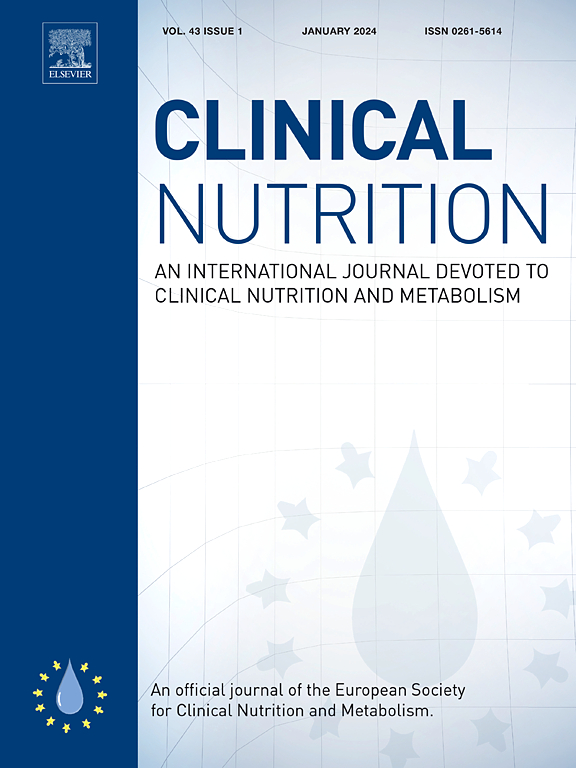Activating nuclear receptor subfamily 2 group F member 2 in adipocyte stem cells rescues beige adipocyte metabolism impaired by excess early-life omega-6 fatty acids
IF 6.6
2区 医学
Q1 NUTRITION & DIETETICS
引用次数: 0
Abstract
Background and aims
Developmental exposure to an elevated ratio of omega-6 (n6) to omega-3 (n3) fatty acids (FA) is linked to increased infant body fat and risk of future childhood obesity. We demonstrated in mice that the high n6/n3 developmental exposure reduced nuclear receptor subfamily 2 group F member 2 (NR2F2) in Adipocyte Stem Cells (ASCs), coincident with an altered ASC mitochondrial expression profile and increased white adipose accumulation in pups. This suggested that NR2F2-low ASCs might adopt a nutrient-storage phenotype. Here, we tested the hypothesis that NR2F2 is required in ASCs to undergo beige adipogenesis and metabolism needed during postnatal life for energy and thermogenesis.
Methods
C57BL/6J dams were randomized to either n6-rich or balanced n6/n3 control diets at the time of mating and underwent normal gestation and parturition. On postnatal day 12 (PND12), whole-body offspring metabolism was quantified by indirect calorimetry in conjunction with 13C-palmitate and 13C-glucose tracing. Inguinal fat pad ASCs were isolated by flow cytometry to assess adipocyte differentiation potential, global gene expression and proteomics, and mitochondrial oxidation. NR2F2 was transiently re-activated in vitro in ASCs with its ligand, 1-deoxysphingosine (1-DSO), and NR2F2 was ablated in ASCs ex vivo using homozygous floxed Nr2f2 pups to determine loss of function, ensure specificity of 1-DSO treatment during gain of function.
Results
Excess developmental n6-FA exposure reduced whole-body 13C-palmitate and 13C-glucose oxidation, diminished PND12 pup energy expenditure, and increased triacylglyceride accumulation in inguinal adipose. In ASCs isolated from n6-FA exposed pups, NR2F2 was decreased. These NR2F2-low ASCs formed downstream adipocytes with decreased beige metabolic regulators peroxisome proliferator-activated receptor gamma coactivator 1-alpha (PGC1α), peroxisome proliferator-activated receptor gamma (PPARγ), PR domain containing 16 (PRDM16), and uncoupling protein 1 (UCP1), had lower glycolysis and lipid metabolism enzymes, oxidized lipid and glucose at lower rates, and had increased lipogenic enzymes. Ex vivo deletion of Nr2f2 from ASCs recapitulated the metabolic deficits observed in the adipocytes derived from NR2F2-low ASCs isolated from n6-FA exposed pups. NR2F2 loss disrupted beige regulator induction, reduced adipocyte FAO, and promoted lipogenesis pathways, mirroring the n6-FA phenotype. Transient NR2F2 activation of ASCs from n6-FA pups using 1-DSO restored induction of beige regulators, increased mitochondrial oxidative phosphorylation enzymes, reduced lipogenic/storage pathways, ultimately enhancing nutrient oxidation.
Conclusions
These findings demonstrate that excess n6-FA developmental exposure disrupts NR2F2-mediated ASC fate determination, leading to formation of nutrient-storing, lipogenic adipocytes. This work highlights NR2F2 as an important upstream or parallel regulator necessary for beige adipogenesis and underscores its activation as a potential therapeutic approach to mitigate early-life obesity risk.
Geo record
GSE284936; Token = orkvgqayblshjsds
激活脂肪干细胞中的核受体亚家族2组F成员2可挽救因早期过量ω -6脂肪酸而受损的米黄色脂肪细胞代谢
背景和目的发育过程中暴露于omega-6 (n6)与omega-3 (n3)脂肪酸(FA)比例升高与婴儿体脂增加和未来儿童肥胖风险有关。我们在小鼠实验中证明,高n6/n3发育暴露降低了脂肪干细胞(ASCs)的核受体亚家族2组F成员2 (NR2F2),与ASC线粒体表达谱的改变和幼崽中白色脂肪积累的增加相一致。这表明nr2f2含量低的ASCs可能具有营养储存表型。在这里,我们验证了NR2F2在ASCs中需要进行米黄色脂肪形成和出生后生命所需的能量和产热代谢的假设。方法配种时将sc57bl /6J母鼠随机分为富氮组和平衡氮/氮对照组,正常妊娠和分娩。在出生后第12天(PND12),通过间接量热法结合13c -棕榈酸酯和13c -葡萄糖示踪法定量子代全身代谢。通过流式细胞术分离腹股沟脂肪垫ASCs,评估脂肪细胞分化潜力、整体基因表达和蛋白质组学以及线粒体氧化。NR2F2在体外与其配体1-脱氧鞘氨醇(1-DSO)一起在ASCs中短暂重新激活,并使用纯合子捆绑NR2F2幼崽在ASCs中消融NR2F2以确定功能丧失,确保1-DSO治疗在功能获得期间的特异性。结果发育过程中过量的n6-FA暴露降低了全身13c -棕榈酸酯和13c -葡萄糖氧化,减少了PND12幼犬的能量消耗,增加了腹股沟脂肪中甘油三酯的积累。在n6-FA暴露的幼崽分离的ASCs中,NR2F2降低。这些低nr2f2的ASCs形成下游脂肪细胞,其代谢调节因子过氧化物酶体增殖物激活受体γ辅助激活因子1- α (PGC1α)、过氧化物酶体增殖物激活受体γ (PPARγ)、PR结构域16 (PRDM16)和解偶联蛋白1 (UCP1)减少,糖酵解和脂质代谢酶降低,脂质和葡萄糖氧化率降低,脂质和葡萄糖氧化率降低,脂肪生成酶增加。体外Nr2f2缺失重现了从n6-FA暴露幼崽中分离的低Nr2f2 ASCs衍生的脂肪细胞中观察到的代谢缺陷。NR2F2缺失破坏了米色调节因子的诱导,降低了脂肪细胞FAO,促进了脂肪生成途径,反映了n6-FA表型。使用1-DSO对n6-FA幼崽的ASCs进行瞬时NR2F2激活,恢复了米色调节因子的诱导,增加了线粒体氧化磷酸化酶,减少了脂肪生成/储存途径,最终增强了营养氧化。这些发现表明,过量的n6-FA发育暴露会破坏nr2f2介导的ASC命运决定,导致营养储存和脂肪生成脂肪细胞的形成。这项工作强调了NR2F2是米色脂肪形成所需的重要上游或平行调节因子,并强调了其激活作为减轻早期肥胖风险的潜在治疗方法。Geo recordGSE284936;Token = orkvgqayblshjsds
本文章由计算机程序翻译,如有差异,请以英文原文为准。
求助全文
约1分钟内获得全文
求助全文
来源期刊

Clinical nutrition
医学-营养学
CiteScore
14.10
自引率
6.30%
发文量
356
审稿时长
28 days
期刊介绍:
Clinical Nutrition, the official journal of ESPEN, The European Society for Clinical Nutrition and Metabolism, is an international journal providing essential scientific information on nutritional and metabolic care and the relationship between nutrition and disease both in the setting of basic science and clinical practice. Published bi-monthly, each issue combines original articles and reviews providing an invaluable reference for any specialist concerned with these fields.
 求助内容:
求助内容: 应助结果提醒方式:
应助结果提醒方式:


